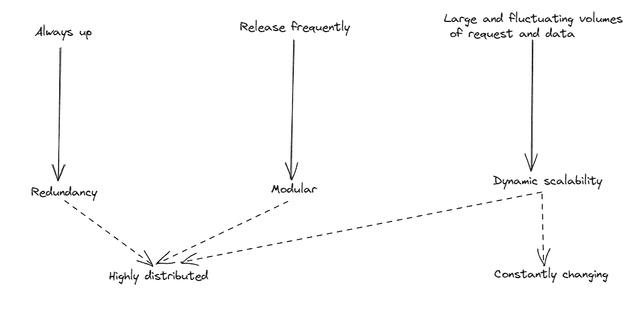What is cloud native
“Cloud-native” is one the most popular buzzwords that you can come across as a software engineer. This articles will discuss some key takeaways to know about “cloud-native” term, why does it matter and how is it different from “microservices architecture”.
Today’s application requirements
The ubiquity of internet has pushed the boundaries of user’s expectation to the application that they use daily. Here are some key requirements for any popular applications:
Zero downtime
Gone are the days when even short maintenance windows during which applications are unavailable are tolerated. Nowadays, applications are expected to be available 24/7 without any downtime.
Frequent software releases
Users are excited for whizzbang new features. Developers want to release a feature as soon as possible and get a quick feedback. In order to do release software more frequently, we need an architecture that enables agility and helps us to build the software more robustly.
Great number of connected devices
Gone are the days that we only have PC and laptop connected to internet. Nowadays, apart from PC and laptop, an application must be support at least two mobile device platforms, iOS and Android, desktop app, tablet,… In some cases, sensors and devices such as cameras, thermostats,… must also be supported. That means two requirements. First, the number of requests sent to the system increase so the system must adapt to expanding demands. Second, the volume of data flowing over internet has significantly increased.
Characteristics of a modern application
In order to fulfill all above mentioned requirements, a modern application need to have following characteristics:
- Redundancy: In order to ensure the system to be up 24/7, we need to have a system with redundant nodes to compensate for inevitable failures.
- Modularity: The goal here is to release code frequenetly. A monolith application with many closely interrelated modules doesn’t allow this. In recent time, it’s been proven that software made up of smaller, loosely coupled and indepently deployable components enables more flexible release model. This architecture is often called microservices.
- Dynamic scalability: As a result of tidal waves of requests and data volumes, the software is required to be scaled dynamically. The resources need to be scaled up in rush hours and scaled down in other circumstances.
The picture below was taken from the book “Cloud native patterns”, depicts the core characteristics of a cloud-native software based on its requirements
Definition of cloud-native
All those requirements, characteristics along with the availability of new platform on which you can run the software, lead to a new architectural style for software: cloud-navtive
Cloud-native software is highly distributed, must operate in a constantly changing environment, and is itself constantly changing.
Cloud vs cloud-native
Let’s take a closer look at “cloud-native” definition. The software must operate in a constantly changing environment and cloud is a constantly changing environment. When you have a “cloud-native” software, your software will run well in cloud. You might say that this software feels quite at home in the cloud. It’s native of that land.
Cloudis about where we’re computing.Cloud-nativeis about how
Cloud vs microservices
One of the requirements for cloud-native software is the modularity. Microservices architecture allows for the creation of modular, independently deployable components by breaking a monolithic application into smaller components. Therefore, cloud native and microservices are very related concepts. They should go hand-in-hand, but it is possible to have a microservices-based application that is not cloud native
Summary
The key requirements for modern applications call for enabling rapid iteration and frequent releases, zero downtime, and a massive increase in the volume and variety of the devices connected to it. Cloud-native applications can remain stable, even when the infrastructure they’re running on is constantly changing or even experiencing difficulties. Cloud is about where software runs and cloud-native is about how it runs.
